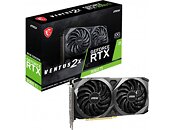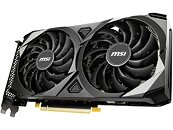Raevenlord
News Editor
- Joined
- Aug 12, 2016
- Messages
- 3,755 (1.16/day)
- Location
- Portugal
| System Name | The Ryzening |
|---|---|
| Processor | AMD Ryzen 9 5900X |
| Motherboard | MSI X570 MAG TOMAHAWK |
| Cooling | Lian Li Galahad 360mm AIO |
| Memory | 32 GB G.Skill Trident Z F4-3733 (4x 8 GB) |
| Video Card(s) | Gigabyte RTX 3070 Ti |
| Storage | Boot: Transcend MTE220S 2TB, Kintson A2000 1TB, Seagate Firewolf Pro 14 TB |
| Display(s) | Acer Nitro VG270UP (1440p 144 Hz IPS) |
| Case | Lian Li O11DX Dynamic White |
| Audio Device(s) | iFi Audio Zen DAC |
| Power Supply | Seasonic Focus+ 750 W |
| Mouse | Cooler Master Masterkeys Lite L |
| Keyboard | Cooler Master Masterkeys Lite L |
| Software | Windows 10 x64 |
MSI are seemingly readying themselves to update their RTX 3060 Ti Ventus 2X graphics card with a relatively deep revision. The new Ventus 2X V1 graphics card keeps all the same frequencies and clocks of the previous Ventus 2X (1695 MHz boost clock in the OC model), and the same TGP of 200 W. The bulk of the revisions are focused on the cards' power delivery and heat dissipation systems.
The new, revised Ventus 2X V1does away with the original's 2x 8-pin connectors, and offers a single 8-pin connector for power delivery purposes. This could mean lowered overclocking ceilings for the card, but I suppose we'll only know the answer to that when these are out there in the wild. The fact that MSI also revised the cooling system, however, seems to give credence to that overclocking headroom theory: with less power being (possibly) delivered to the card, MSI has seen it fit to make the Ventus 2X V1 a thinner card compared to its predecessor (it's a 2-slot card now, at 42 mm, whereas it was a 2.2-slot in the first revision, at 52 mm).





View at TechPowerUp Main Site
The new, revised Ventus 2X V1does away with the original's 2x 8-pin connectors, and offers a single 8-pin connector for power delivery purposes. This could mean lowered overclocking ceilings for the card, but I suppose we'll only know the answer to that when these are out there in the wild. The fact that MSI also revised the cooling system, however, seems to give credence to that overclocking headroom theory: with less power being (possibly) delivered to the card, MSI has seen it fit to make the Ventus 2X V1 a thinner card compared to its predecessor (it's a 2-slot card now, at 42 mm, whereas it was a 2.2-slot in the first revision, at 52 mm).





View at TechPowerUp Main Site



